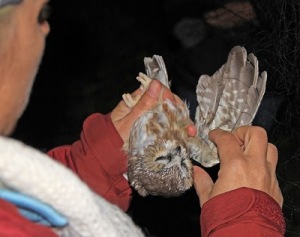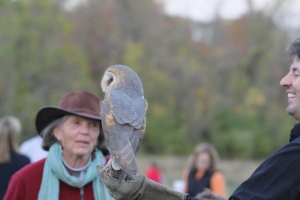Friends of Rushton Banding,
What a fine week it was for our little banding station . Tuesday 10/26 turned out to be a super day. We caught 40 birds including our first Fox Sparrow of the season which received many oohs and aahs for its warm russet or foxlike coloring, larger and rounder body and the sweet expression on it’s face. We try to avoid “anthropomorphizing” our birds and their behaviors, but sometimes the cute factor is too strong to resist. This is the 8th sparrow species on our station list. We also have been catching Cedar Waxwings and Purple Finches in good numbers. 
An impromptu session was held on Thursday to make up for a rainy Wed. Just before dawn hundreds of Hermit Thrush could be heard overhead in the night sky making their “chuck” contact calls above the tree tops. This hint that birds were moving in large numbers was confirmed as I set net 6 and disturbed bunches of thrush who were feeding on the ground. Particularly after a rain, thrushes search the ground for bugs that have fallen onto a road or path where they are easy to see. Only a third of the net was open before one thrush jumped right in. Even with two capable helpers, Lou Hahn and Denis Brennan, I decided to decrease the number of nets used until my suspicions were disproved. So, with only six nets we caught 52 birds of 13 species and as validation of the pre-dawn thrush flight, 12 of our birds were Hermit Thrush. We might have caught a hundred or more, but by limiting the nets, processing was fast, smooth and easy on the birds.
The very fine audio-lure that Lou built for us is attracting Saw-whet Owls to Rushton Farm with it’s repetitive “toot” call which the owls can’t resist investigating. While waiting to in the barn, we felt the wind rise and the temperature drop around 9:00 pm. It had been falling gradually, but then the real change came. At 9:50 we caught our first owl and by then it was “Where’s my jacket?” time. Moon rise was 10:30 (not good, too easy to be seen and eaten by a larger owl) , but we caught another owl at 11:55 when the wind was roaring and the temp below 50. On Friday night we banded with visitors present and caught two more owls, bringing the total for the season to six. We’ll keep trying for owls until the migration ends in late Nov. In the meantime, it’s owl in a night’s work to attract and catch these tiny creatures..
Doris









